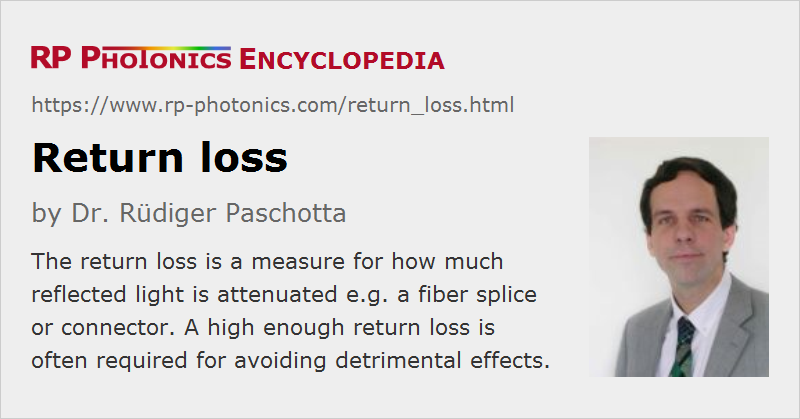Return Loss
Acronym: ORL
Definition: a measure for how much reflected light is attenuated
Alternative term: reflection loss
German: Reflexionsdämpfung
Units: dB
How to cite the article; suggest additional literature
Author: Dr. Rüdiger Paschotta
The return loss (or reflection loss) of some optical device (or a combination of devices) specifies how much lower the optical power of the returning (reflected) light is compared with the light sent into the device. Usually, the return loss is specified in decibels. For example, if the return loss is 30 dB, the returning light has only 1/1000 of the power of the incident light. Note that only directly returning light is counted – and no light which is reflected into a different direction, e.g. at an angle-cleaved fiber end.
The term return loss is most often used in cases where ideally there would be no reflected light at all. For example, a fiber coupler (which is a unidirectional coupler) should split the power of incident light between two or more outputs, but should not reflect any light back to the source (assuming that no light is reflected from its outputs). The return loss would then be infinite. However, some finite return loss (often many tens of decibels) may be caused, for example, when the fiber of the coupler has different guiding properties (refractive index, effective mode area, etc.) than the fibers spliced to the input and output of the fiber coupler. Also low-quality splices can lead to increased return loss. Good splices should have a return loss of at least 45 dB. With angle-cleaved splices, even substantially higher values are possible.
Similarly, a Faraday isolator would ideally not reflect any light, but some finite return loss results from imperfections. The actual return loss may be specified for a situation where all light from the output is reflected back to the isolator.
A fiber itself can have some finite return loss due to Rayleigh backscattering. This is exploited in the context of optical time-domain reflectometry, which is widely used for monitoring the status of fiber-optic links. There, one measures the time-resolved return loss, which can reveal various information of interest, for example propagation losses of fibers and isolated losses and reflections e.g. due to faulty fiber splices.
Importance of High Return Loss
In various situations, it can be important that the return loss of some optical arrangement is sufficiently high. Some examples:
- Many lasers, in particular single-frequency lasers, are sensitive to back-reflected light. A too low return loss of attached devices may destabilize the laser operation, i.e., cause excessive laser noise and/or emission on multiple optical frequencies.
- High-gain optical amplifiers, for example fiber amplifiers (but not optical parametric amplifiers), are also sensitive, because any back-reflected light will again be amplified, and might destroy parts of the amplifier or components connected to its input.
- In optical fiber communications, back-reflected light may increase the bit error rate. Time-resolved return loss measurements (see above) are extensively used for monitoring fiber-optic links.
Questions and Comments from Users
Here you can submit questions and comments. As far as they get accepted by the author, they will appear above this paragraph together with the author’s answer. The author will decide on acceptance based on certain criteria. Essentially, the issue must be of sufficiently broad interest.
Please do not enter personal data here; we would otherwise delete it soon. (See also our privacy declaration.) If you wish to receive personal feedback or consultancy from the author, please contact him e.g. via e-mail.
By submitting the information, you give your consent to the potential publication of your inputs on our website according to our rules. (If you later retract your consent, we will delete those inputs.) As your inputs are first reviewed by the author, they may be published with some delay.
See also: fiber couplers, Faraday isolators, decibel, insertion loss, Rayleigh scattering, optical time-domain reflectometers
and other articles in the category general optics
 |



If you like this page, please share the link with your friends and colleagues, e.g. via social media:
These sharing buttons are implemented in a privacy-friendly way!